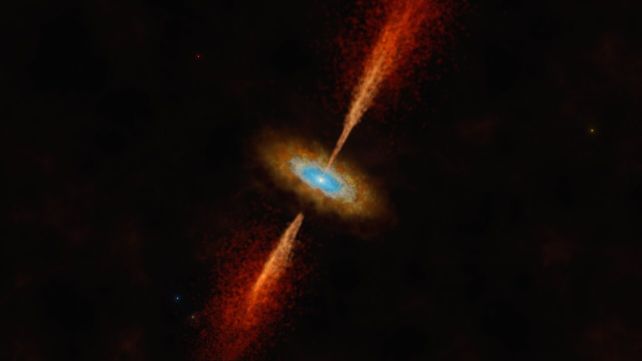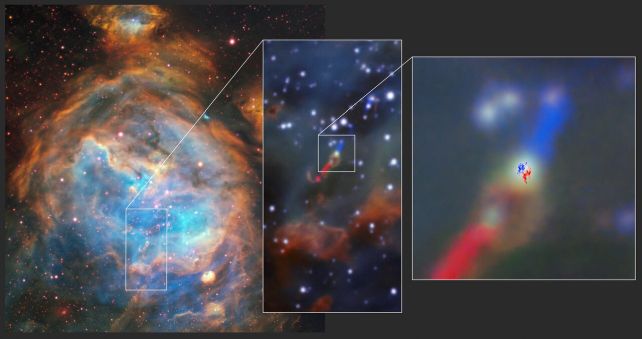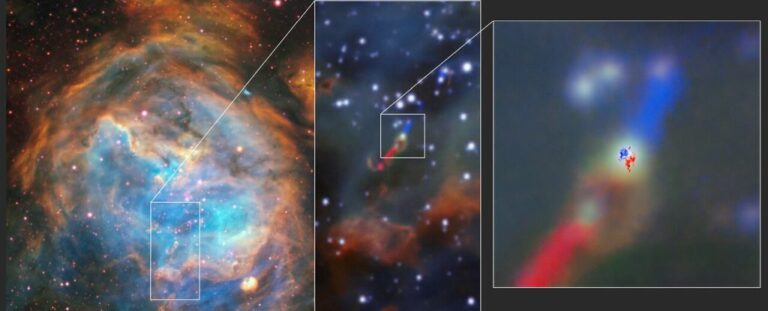For the First Time, Astronomers Detect a Disk Orbiting a Star in a Different Galaxy
Astronomers have made a remarkable discovery of an extended disk composed of dust and gas, spinning in orbit around a distant star. This occurrence is not uncommon during the evolution of a star and its planetary system. However, what sets this finding apart is that it is the first instance of such a disk observed around a star in an entirely different galaxy, beyond our own.
This remarkable feature was detected in the Large Magellanic Cloud, a small galaxy located approximately 179,000 light-years away from the Milky Way. While it may seem logical to assume that the processes of star formation are universal, we have never been able to witness their intricacies beyond our own galaxy until now.
Astronomer Anna McLeod from Durham University in the UK expresses her astonishment, stating, “When I initially observed indications of a rotating structure in the ALMA data, I could hardly believe that we had identified the first extragalactic accretion disc. It was an extraordinary moment.” She further adds, “We understand that discs play a crucial role in the formation of stars and planets within our galaxy. Now, for the very first time, we are witnessing direct evidence of this phenomenon in another galaxy.”

Stars are formed when dense clumps within clouds of molecular gas and dust in interstellar space collapse under gravity. As these clumps grow denser, they begin to spin and attract more material from the surrounding cloud. However, this material doesn’t simply fall onto the protostar haphazardly. Instead, it forms a disk around the star’s equator and gradually falls onto it in a controlled and steady stream, resembling water flowing down a drain.
After the star formation process is complete, the remaining disk material clumps together to give rise to the various components of a planetary system, including planets, asteroids, meteors, comets, and dust. This is why the planets in our Solar System orbit the Sun in a relatively flat plane. In a way, we can liken ourselves to the sentient mold that grows on the remnants of the Sun’s breakfast.
The Atacama Large Millimeter/submillimeter Array (ALMA), a highly advanced radio telescope, has captured images of numerous such disks in different stages of development throughout the Milky Way. Some of these disks exhibit clear gaps, which are believed to be formed by planets coming together as they orbit. However, as objects become more distant, their resolution becomes increasingly challenging, even for a powerful telescope like ALMA.

McLeod and her colleagues initiated their mission to discover a stellar disk beyond our galaxy after analyzing data collected by the Multi Unit Spectroscopic Explorer (MUSE) instrument on the Very Large Telescope. This data revealed indications of a jet within a system called HH 1177.
These jet formations are also indicative of the birth of stars: some of the matter swirling around the developing star is propelled along its magnetic field lines towards the poles, where it is then ejected into space as a powerful jet.
The researchers aimed to identify the presence of the disk within the dusty core of star formation. To achieve this, they utilized ALMA to search for signs of rotation. This rotation can be observed through the alteration of light wavelengths as the source is either pushed towards us, resulting in shortened wavelengths, or pulled away, leading to lengthened wavelengths.
“The frequency of light changes based on the velocity at which the gas emitting the light moves towards or away from us,” explains astronomer Jonathan Henshaw from Liverpool John Moores University in the UK. “This phenomenon is exactly analogous to the change in pitch of an ambulance siren as it passes by, where the sound frequency transitions from higher to lower.”
The ALMA data revealed clear indications of this rotation, which is quite intriguing. The team’s analysis unveiled that the star is both very young and massive, still drawing sustenance from the surrounding disk. This is a fairly typical occurrence. However, there exists a disparity between this star and the protostellar disks discovered in the Milky Way: the HH 1177 disk is observable in optical wavelengths.
According to the researchers, this discrepancy can be attributed to the interstellar environment within the Large Magellanic Cloud. There is significantly less dust present, resulting in the HH 1177 star being less veiled by material compared to young, massive stars in the Milky Way.
Consequently, this discovery holds great importance not only for the study of star formation in diverse environments but also for understanding the limitations these environments impose on the process.
McLeod emphasizes the significance of this finding, stating, “We are currently experiencing a period of rapid technological advancement in astronomical facilities. The ability to investigate the formation of stars at such immense distances and within a distinct galaxy is truly exhilarating.”
The research findings have been published in the esteemed journal, Nature.
This article is republished from sciencealert under a Creative Commons license. Read the original article.
Do not forget to share your opinion with us to provide you with the best posts !




0 Comments